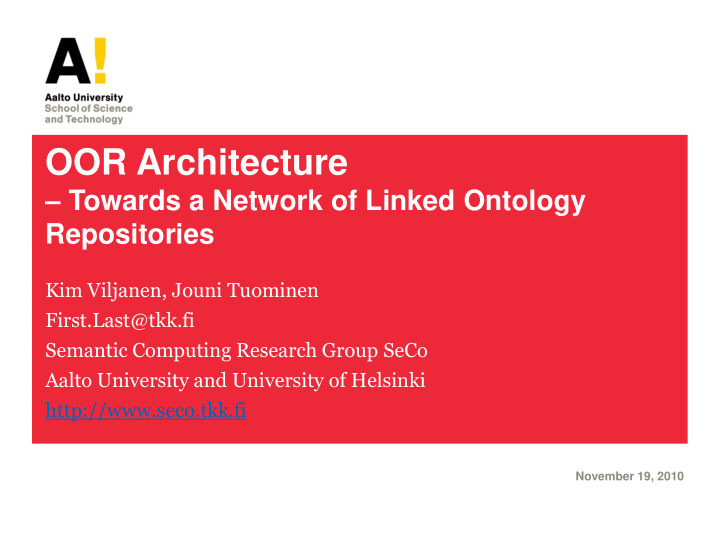



OOR Architecture – Towards a Network of Linked Ontology Repositories Kim Viljanen, Jouni Tuominen First.Last@tkk.fi Semantic Computing Research Group SeCo Aalto University and University of Helsinki http://www.seco.tkk.fi November 19, 2010
Outline of the presentation • Our background • Is there a “one - size fits all” OOR solution? • Our suggestion for the OOR architecture • What next? • Please forgive us if some of the issues have been already discussed.
Our (=SeCo) background • Semantic Computing Research Group (SeCo), http://www.seco.tkk.fi/ • Building a national semantic web infrastructure in Finland (FinnONTO), 2002- • Running an ontology repository ONKI, 2008- (” production ” use) • Use cases we have been focusing on: annotating, ontology-based information retrieval , … • Eero Hyvönen, Kim Viljanen, Jouni Tuominen and Katri Seppälä: Building a National Semantic Web Ontology and Ontology Service Infrastructure--The FinnONTO Approach. Proceedings of the European Semantic Web Conference ESWC 2008 . • Kim Viljanen, Jouni Tuominen and Eero Hyvönen: Ontology Libraries for Production Use: The Finnish Ontology Library Service ONKI. Proceedings of the European Semantic Web Conference ESWC 2009 . • Kim Viljanen, Jouni Tuominen, Mikko Salonoja and Eero Hyvönen: Linked Open Ontology Services. Workshop on Ontology Repositories and Editors for the Semantic Web (ORES 2010) , ESWC 2010. • For all publications, see: http://www.seco.tkk.fi/services/onki/
What can we bring to the table? • Ideas and experience – Building a national semantic web infrastructure – Running an ontology repository, 2008- (”production” use) – ”LOOS API” – accessing distributed ontology repositories; implementing user-interfaces on top of the LOOS API – ONKI Selector widget – Implementations for different user-interfaces and ontology servers (generic ”ONKI SKOS”, geo ontology server, …) – …
Why we want to participate in OOR • Sharing and developing best practices – APIs, specifications – Tools, components • Improving our national ontology repository ONKI with content from international ontology repositories • Networking and building a global community • Benchmarking our work
There is no ”one - size fits all” solution • Different use cases – metadata creators (”annotators”) – end-users that benefit from ontologies in e.g. information retrieval – ontology developers – developers of ontology-enhanced applications – … • Users with different background skills – non-expert library customers vs. subject specialists • Different types of ontologies need for different kind of user interfaces – E.g. thesaurus-like concept ontology vs. geographical ontologies • Different kinds of ontology service providers – E.g. corporate internal use vs. public service Is it possible to implement a single OOR server that addresses these needs? (and needs that we don’t know)
Status now: non-interlinked repositories addressing different needs => What could we do together? … Bioportal Cupboard Pronto ONKI.fi TONES …
OOR = Connecting repositories OOR Registry OOR Network … Bioportal Cupboard Pronto ONKI.fi TONES …
OOR Architecture: P2P User-Interface X User-Interface Y OOR Ontology Repository X Ontology Repository Y API sameAS subClassOf
OOR Architecture: Global Other applications … Global Search OOR Registry of Repositories OOR API #2 OOR Ontology Repository X Ontology Repository Y API sameAS subClassOf
So what should the OOR APIs be? • There could be e.g. following APIs: – OOR Content – get the content of a specific concept/ontology/repository – OOR Search – keyword search for concepts, ontologies/repository – OOR Update – update concepts/ontologies/repository – OOR Network – inter-repository content sharing, e.g. indexes • API design principles – As simple as possible • let the OOR implementators choose which functionalities they will implement • do not require to implement all APIs – Support many technical solutions • E.g., REST, Linked Data, Web Service, SPARQL… • Clients/backends may be implemented e.g. with Java, PHP, Python, JavaScript… – A test suite for each API is needed • To help API implementators validate that their API implementation works correctly • E.g. implementing OOR API to your existing Ontology Repository or your CMS
LOOS API as an example • search(query): supports keyword, type, etc. • getLabels(conceptURI) • getEquivalentConcepts(conceptURI) • getConceptHierarchy(conceptURI) • getOntologyOverview(ontologyURI) • …
What next? • Focus on APIs – Define APIs – Create test suites & baseline implementations • Focus on enabling an ecosystem of Ontology Repositories (not on doing everything by ourselves) – Make a one-slide presentation on what are the benefits of joining the OOR network – Write a guide on implementing OOR compatible servers • In the spirit of Bizer et al. – How to Publish Linked Data on the Web – Should we organize a ESWC 2011 workshop on OOR?
Could we have something like this?
Recommend
More recommend